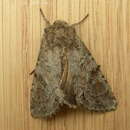Biology
provided by Arkive
The Pale Shining Brown is a single-brooded species, the adults of which are on the wing from mid-June to mid-July. The precise details of the life history of this moth have yet to be elucidated in the wild, however the caterpillars will feed on dock, dandelion and other herbaceous plants in captivity (2). It is likely that the overwintering stage is the caterpillar (2).
Conservation
provided by Arkive
The Species Action Plan for the Pale Shining Brown moth, produced as part of the UK Biodiversity Action Plan (UK BAP) aims to maintain the current known populations and enhance these by 2010. Suggested action includes increasing the amount of suitable habitat available at occupied sites and linking fragmented sites. Survey work and research into the causes of the decline and habitat needs of the species have also been proposed (1).
Description
provided by Arkive
Adults are pale reddish-brown in colour with slightly paler hindwings and a shiny appearance, hence the common name (3). The caterpillar has a pale brown back, becoming greener towards the underside (3).
Habitat
provided by Arkive
This species is predominantly found on scrubby grassland sites, typically with calcareous soil (1).
Range
provided by Arkive
The Pale Shining Brown moth was once widespread in England south of the Severn and the Humber, however it has been recorded from just 20 sites since 1980 (1) and is now recorded with any regularity from just two or three localities (5). A greyish form occurs occasionally as a migrant into south-east England (6). It is known from most other European countries (1).
Status
provided by Arkive
Classified as Local in Great Britain (1).
Threats
provided by Arkive
The reasons for the decline of the species have not yet been identified (1).
Polia bombycina
provided by wikipedia EN
Polia bombycina (pale shining brown) is a moth of the family Noctuidae. It is found in the Palearctic realm from Ireland to Japan including the Russian Far East and Siberia.
Technical description and variation
The wingspan is 43–52 mm. Forewing pale or dark lilac grey, more or less suffused with grey brown, especially in costal half; a slight dark basal streak below median vein; claviform stigma outlined with black: orbicular and reniform large, paler, with dark centres; reniform with white on outer edge and often followed by a rufous patch; submarginal line preceded by blackish wedge-shaped marks, and acutely indented on submedian fold; hindwing brownish fuscous; — specimens in which the glaucous tint predominates are ab. nitens Haw.; — the much rarer uniformly reddish brown form is unicolor Tutt - flavescens Spul., from the Bukowina, has the forewings pale brownish yellow; — ab. mongolica Stgr. the common form in central and eastern Asia is uniformly darker grey brown with a reddish undertone, the submarginal line equally distinctly indented.[1]

Moth and larva in
Karl Eckstein Die Schmetterlinge DeutschlandsLarva and moth (figures 10a, 10b)
Biology
The moth flies from May to July depending on the location.
Larva pale brown; dorsal line pale; some dark oblique streaks; a whitish dark -mottled lateral line containing the spiracles which are bright red-brown, edged with black. The larvae feed on various herbaceous plants - Betula sp., Alnus incana, Sorbus aucuparia, Prunus padus, Pimpinella saxifraga, Angelica silvestris, Galium verum, Leucanthemum vulgare, Artemisia campestris, Artemesia absinthium, Artemesia vulgaris, Hieracium umbellatum.[2]
References
-
^ Seitz, A. Ed., 1914 Die Großschmetterlinge der Erde, Verlag Alfred Kernen, Stuttgart Band 3: Abt. 1, Die Großschmetterlinge des palaearktischen Faunengebietes, Die palaearktischen eulenartigen Nachtfalter, 1914
-
^ "Robinson, G. S., P. R. Ackery, I. J. Kitching, G. W. Beccaloni & L. M. Hernández, 2010. HOSTS - A Database of the World's Lepidopteran Hostplants. Natural History Museum, London".

- license
- cc-by-sa-3.0
- copyright
- Wikipedia authors and editors
Polia bombycina: Brief Summary
provided by wikipedia EN
Polia bombycina (pale shining brown) is a moth of the family Noctuidae. It is found in the Palearctic realm from Ireland to Japan including the Russian Far East and Siberia.
- license
- cc-by-sa-3.0
- copyright
- Wikipedia authors and editors


